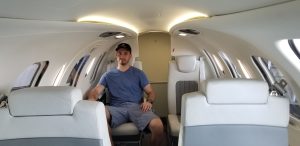 Size matters when its a private jet charter. Luckily there are a lot of jet sizes to choose from when it comes to selecting your charter. They start in the category of very light jet all the way to a Boeing Business Jet that is the size of a commercial airliner. Today we will take a look at the entry level of the 4 categories in the air charter world, the very light jets. Since there are many in this category, we will discuss 3 of the hotter very light jets. It really comes down to what the mission is and how many people will be aboard. It also can have a lot to do with who will be flying. Sometimes the CEO will need his or her own space away from the travel group, and then only certain jets will do. Or the trip is for a large group and the seating capacity will be the main priority. Cargo space may be a deciding factor for a golfing weekend or a fashionista with an entourage of luggage. There are also various cruise speeds and the range flown without a fuel stop to consider. All in all, the process of choosing the right jet for a charter can be simple or at times very complex, especially on a multi-leg tour. Let’s look at the Very Lights this week.
Size matters when its a private jet charter. Luckily there are a lot of jet sizes to choose from when it comes to selecting your charter. They start in the category of very light jet all the way to a Boeing Business Jet that is the size of a commercial airliner. Today we will take a look at the entry level of the 4 categories in the air charter world, the very light jets. Since there are many in this category, we will discuss 3 of the hotter very light jets. It really comes down to what the mission is and how many people will be aboard. It also can have a lot to do with who will be flying. Sometimes the CEO will need his or her own space away from the travel group, and then only certain jets will do. Or the trip is for a large group and the seating capacity will be the main priority. Cargo space may be a deciding factor for a golfing weekend or a fashionista with an entourage of luggage. There are also various cruise speeds and the range flown without a fuel stop to consider. All in all, the process of choosing the right jet for a charter can be simple or at times very complex, especially on a multi-leg tour. Let’s look at the Very Lights this week.
Very Light Jets – Size Matters
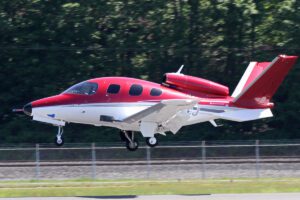
The Cirrus Visionjet has a capacity of 7 passengers including crew with a max operating altitude of 31,000 ft. Its max cruising speed is 305 knots true airspeed (ktas) with a max takeoff weight of 6,000 lbs and 1400 lb payload. The plane has a max range of 1,275 nautical miles (NM) with an average flight range of 950NM. The jet has some very interesting features like its “Safe Return” autonomous feature, where the plane could fly itself if for some reason the pilot became incapacitated during the flight. It would be able to fly at the correct altitude, maintain the proper speed, and even land itself all at the touch of a button. The plane has an iconic V-tail design and is powered by a Williams International FJ33-5A turbine engine with Full Authority Digital Engine Control (FADEC). The flight displays are an expansive 14-inches and offer split screen tech for multi feature display. The jet has room for three of these displays allowing the pilot to check the status of all systems easily. The cabins are very modular and they typically can have up to 28 possible seating configurations. The premium leather seating is what you would expect in a more expensive larger jet and the upholstery is first class. I personally like the executive layout, but that will only have 2 passenger seats, room for luggage, and the pilot and co-pilot seats in the flight deck. The “complete” configuration is more common and will give you passenger seating for five but is more comfortable for four as in most very lights. The Cabin width is 5.1 ft and a height of 4.1 ft so you will need to bend over to get in or out of your seat as expected in these smaller jets. Like we said, size matters. You can expect to pay roughly $2,500 USD per hour to charter the Cirrus Vision Jet.
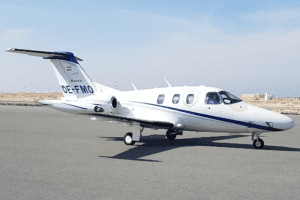
The Eclipse 550 Jet has the capacity of 6 passengers including crew with a max operating altitude of 41,000 ft. Its max cruising speed is 375 ktas with a max takeoff weight of 6,000 lbs and a lower 636 lb payload. This plane has a max range of 1,125 nautical miles with a very efficient twin-engine jet fuel consumption of only 59 gallons per hour. It also comes equipped with FADEC which translates into reduced pilot workload. It is powered by twin Pratt & Whitney PW610F turbofan engines that are specially designed for the point to point travel of the new generation of private flyers. Pilots enjoy an advanced Flight Management Systems with benefits such as enhanced situational awareness, electronic charts and maps, display and control of the aircraft systems, and integrated autopilot control panel. The interior has the feel of a luxury suite with ergonomically designed seats with ample space to store your luggage. The cabin width is 4.6 ft and the height is 4.2 ft so a little narrower than the Cirrus. The 550 will typically have a $2,850 USD per hour rental rate within the range for these very light jets.
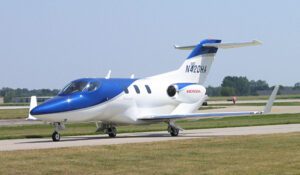
The Honda HA-420 Jet has the capacity of 7 passengers including crew and a max operating altitude of 43,000 ft. Its max cruising speed is 420 ktas with a max take off weight of 10,600 lbs and a 547 lb payload. The plane has a max range of 1,206 nautical miles with a sleek design resulting in reduced drag at higher speeds. It has a very prominent over-the-wing engine configuration setting it apart in this class. The jet is powered by twin GE Honda HF120 turbofans developed under the GE-Honda partnership. It is a low wing monoplane that has a composite fuselage and aluminum wing. The typical flight deck features the first touchscreen controlled all-digital glass integration with the Garmin G3000 avionics system. The cabin is 5 ft wide with a height of 4.8 ft. It feels a lot bigger when you are seated inside for sure which comes from its cutting edge combination of co-cured integral structure and honeycomb sandwich structures. The leather seating in the cabin is wide and ample for larger passengers, can be moved inwards for better headroom and shoulder space, and has an executive feel. The HA-420 will typically be a bit less expensive these days at a $2,400 hourly rental rate as the newer more expensive Honda Elite Jet becomes more widely available.
Of course there are many more options to choose from than just the aforementioned trio. Offerings from Cessna like the Mustang, the Citation M2 and the Cessna Citation jets all require a mention here and are very popular choices. They are great planes in this category and are definitely tried and true. The three we featured are a little more bold in style and appeal to the newer gen set becoming jet set. Next week will will look at the workhorses of the light jet entries in our charter world.
Until then, Be Social, Fly Private! Sign Up!
Follow us on Instagram Follow us on Facebook
*These are base hourly rates per craft type with no ferry times, FET taxes, taxi time, or fuel surcharges. Typical final hourly rates will be higher based on category and timing.

 The 50 hour guideline for flying private.
The 50 hour guideline for flying private. Private air charter has many challenges ahead. Pictured above is one of our Managing Partners, Katherine Koch, my darling wife and future commercial ATP pilot. Unfortunately she only represents a small number of future commercial pilots headed towards the private air charter industry or a major commercial airlines. The pilot shortage is private aviation’s number one challenge, further exacerbated by competition for pilots from airline and freight operations. The airlines are offering huge sign-on bonuses, great work schedules, amazing benefits packages, and lofty annual salaries particularly for anyone experienced enough to graduate to the left seat of these jets. After forcing early retirements during the pandemic, the majors are desperately playing catch-up in this highly competitive industry. Upward mobility was already accelerated before the pandemic but now in the aftermath pilots are upgrading at minimums and jumping from regional to major airlines with unprecedented speed. There is a huge presence in aviation schools by most of the regional airlines that feed these major carriers, something we are not seeing enough of by the private air charter industry. It is a major challenge among many others we will discuss further in this article. In this article, we will take a quick look back 5 years ago at the challenges to private air charter that have shaped the current industry. In next week’s post, we will take a deeper dive into the current private air charter industry.
Private air charter has many challenges ahead. Pictured above is one of our Managing Partners, Katherine Koch, my darling wife and future commercial ATP pilot. Unfortunately she only represents a small number of future commercial pilots headed towards the private air charter industry or a major commercial airlines. The pilot shortage is private aviation’s number one challenge, further exacerbated by competition for pilots from airline and freight operations. The airlines are offering huge sign-on bonuses, great work schedules, amazing benefits packages, and lofty annual salaries particularly for anyone experienced enough to graduate to the left seat of these jets. After forcing early retirements during the pandemic, the majors are desperately playing catch-up in this highly competitive industry. Upward mobility was already accelerated before the pandemic but now in the aftermath pilots are upgrading at minimums and jumping from regional to major airlines with unprecedented speed. There is a huge presence in aviation schools by most of the regional airlines that feed these major carriers, something we are not seeing enough of by the private air charter industry. It is a major challenge among many others we will discuss further in this article. In this article, we will take a quick look back 5 years ago at the challenges to private air charter that have shaped the current industry. In next week’s post, we will take a deeper dive into the current private air charter industry.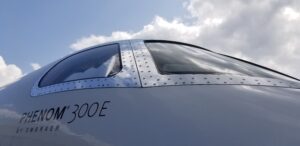
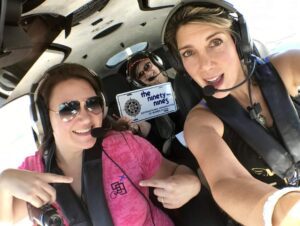 I think I should buy my own jet is a statement I hear often from many of our newly referred clients. Owning your own private jet or even a prop plane is a big endeavor for any person or business. Let’s look at the beginning for people interested in actually owning and flying their own plane or jet.
I think I should buy my own jet is a statement I hear often from many of our newly referred clients. Owning your own private jet or even a prop plane is a big endeavor for any person or business. Let’s look at the beginning for people interested in actually owning and flying their own plane or jet.  Private Flying Rules: FAA Part 91, 121, 135. There are numerous rules and regulations governing all air travel, but let’s take a look at the three most of us fly under. FAA Part 121, covering Domestic, Flag and Supplemental Operations, is the most familiar as it is what all commercial airlines fly under including the major airlines and the regionals. Since we focus primarily on private air travel, charter, emptylegs, et cetera, we will most likely be flying under FAA Part 135 and in our own planes, FAA part 91.
Private Flying Rules: FAA Part 91, 121, 135. There are numerous rules and regulations governing all air travel, but let’s take a look at the three most of us fly under. FAA Part 121, covering Domestic, Flag and Supplemental Operations, is the most familiar as it is what all commercial airlines fly under including the major airlines and the regionals. Since we focus primarily on private air travel, charter, emptylegs, et cetera, we will most likely be flying under FAA Part 135 and in our own planes, FAA part 91.  When we need to get out of harms way. Hurricane Ian’s insured losses continue to mount. Estimated losses are ranged from 53 to 74 billion dollars from Florida to the Carolinas. The modeling firm, RMS *, estimates that the damage will be very close to $67 billion in insured losses. These figures will rank Hurricane Ian as the All-Time costliest storms to hit Florida and place it 2nd only to Hurricane Katrina nationally as pertaining to insured losses. Densely populated areas such as Naples, Ft. Myers, and the barrier Island Sanibel were devastated and the death toll has already surpassed 100 souls**.
When we need to get out of harms way. Hurricane Ian’s insured losses continue to mount. Estimated losses are ranged from 53 to 74 billion dollars from Florida to the Carolinas. The modeling firm, RMS *, estimates that the damage will be very close to $67 billion in insured losses. These figures will rank Hurricane Ian as the All-Time costliest storms to hit Florida and place it 2nd only to Hurricane Katrina nationally as pertaining to insured losses. Densely populated areas such as Naples, Ft. Myers, and the barrier Island Sanibel were devastated and the death toll has already surpassed 100 souls**. Hurricane Ian will go down in history as one of the worst storms to impact the state of Florida in decades. It devastated the west coast of Florida with near Category 5 winds, torrential and unrelenting rain, plus a whopping 12+ ft storm surge. Like its predecessor, Hurricane Andrew, it caused death and destruction in the billions of dollars. 30 years ago, Hurricane Andrew caused 50 billion in damage, destroyed 60,000 homes, and left 170,000 people homeless. We haven’t had enough time to tally the pain caused by Hurricane Ian, but I’m sure the numbers will dwarf those of Andrew. Most of the areas hit were swamps and mangroves back in the early 1900s until men like Carl Fisher and Henry Flagler etched out their respective fortunes turning these same natural landscapes into concrete and coral stone. We no longer have the protection from mother nature’s palm trees, everglades, and mangroves to protect us. Although newer multi-million dollar homes and buildings are engineered with strength to endure these natural disasters, they seem not as well suited for battle as these weather events get more and more powerful with our ever changing climate and environment.
Hurricane Ian will go down in history as one of the worst storms to impact the state of Florida in decades. It devastated the west coast of Florida with near Category 5 winds, torrential and unrelenting rain, plus a whopping 12+ ft storm surge. Like its predecessor, Hurricane Andrew, it caused death and destruction in the billions of dollars. 30 years ago, Hurricane Andrew caused 50 billion in damage, destroyed 60,000 homes, and left 170,000 people homeless. We haven’t had enough time to tally the pain caused by Hurricane Ian, but I’m sure the numbers will dwarf those of Andrew. Most of the areas hit were swamps and mangroves back in the early 1900s until men like Carl Fisher and Henry Flagler etched out their respective fortunes turning these same natural landscapes into concrete and coral stone. We no longer have the protection from mother nature’s palm trees, everglades, and mangroves to protect us. Although newer multi-million dollar homes and buildings are engineered with strength to endure these natural disasters, they seem not as well suited for battle as these weather events get more and more powerful with our ever changing climate and environment.